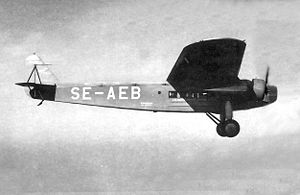Fokker F.VIII
| F.VIII | |
|---|---|
 |
|
| Fokker F.VIII "Jämtland" of Swedish airline ABA, showing the Pratt & Whitney engine installation. | |
| Role | Airliner |
| Manufacturer | Fokker |
| Designer | Reinhold Platz |
| First flight | 12 March 1927 |
| Primary users |
KLM Malert |
| Number built | 11 |
| Developed from | Fokker F.VII |
The Fokker F.VIII (or F.8) was a large twin-engined airliner designed and produced by the Dutch aircraft manufacturer Fokker in the 1920s.
In 1926, the Dutch airline KLM issued a request for an airliner with more passenger capacity than the F.VII variants in operation at the time. Designer Reinhold Platz immediately started work on the F.VIII in response.
The F.VIII featured mixed construction: fuselage and tail section were constructed as a frame of welded steel covered with plywood (sometimes known as multiplex), canvas and duralumin, but the wing framing was all wood covered with plywood. This had become standard Fokker construction and the result was one of their characteristic cantilever high-winged monoplanes.
The F.VIII was Fokker's first twin-engined airliner, a reflection of the increasing power available from the light radials engines of the time. All their previous designs had an engine in the nose, and its absence in the F.VIII lead to less prop-wash wear and tear on the fuselage and much lower vibration levels for passengers. The first aircraft used 358 kW (480 hp) Bristol Jupiter radial engines built under licence by Gnome-Rhone, strut mounted and uncowled under the wings. KLM later re-engined theirs with 391 kW (525 hp) Pratt and Whitney Wasp T1D1 radials, cowled with Townend rings and mounted further forward than the Jupiters. One aircraft, which for part of its life flew as PH-OTO was used to explore the effects of mounting engines in, rather than below the wing. There were concerns that this arrangement, which became standard in later propeller driven aircraft would seriously disturb the airflow over the upper wing. It used 589 kW (790 hp) Wright Cyclones.
The standard cabin accommodated 15 passengers seated three abreast, but KLM chose a more luxurious 12-seat arrangement, well received at the time.
The prototype made its maiden flight on March 12, 1927. 11 F.VIII aircraft were built, three under licence by Manfred Weiss in Budapest. Fokker designed, but did not build a seaplane version designated F.VIIIw.
KLM accepted delivery of the first of their seven on June 24, 1927. They were used exclusively on the European routes. The Hungarian Malert company bought one aircraft and had another three built under licence at the WM factory, all using Gnome-Rhône Jupiter 9A engines. These Budapest airliners flew on Malert's short haul routes; two were lost in crashes.
...
Wikipedia
